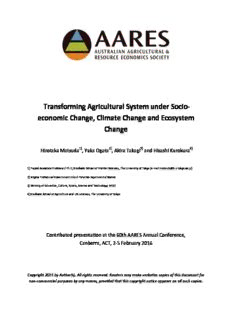
economic Change, Climate Change and Ecosystem Change PDF
Preview economic Change, Climate Change and Ecosystem Change
The World’s Largest Open Access Agricultural & Applied Economics Digital Library This document is discoverable and free to researchers across the globe due to the work of AgEcon Search. Help ensure our sustainability. Give to AgE con Search AgEcon Search http://ageconsearch.umn.edu [email protected] Papers downloaded from AgEcon Search may be used for non-commercial purposes and personal study only. No other use, including posting to another Internet site, is permitted without permission from the copyright owner (not AgEcon Search), or as allowed under the provisions of Fair Use, U.S. Copyright Act, Title 17 U.S.C. Transforming Agricultural System under Socio- economic Change, Climate Change and Ecosystem Change Hirotaka Matsuda1), Yuka Ogata2), Akira Takagi3) and Hisashi Kurokura4) 1) Project Associate Professor / Ph.D, Graduate School of Frontier Sciences, The University of Tokyo (e-mail:[email protected]) 2) Niigata Prefectural Government Inland Fisheries Experimental Station 3) Ministry of Education, Culture, Sports, Science and Technology; MEXT 4) Graduate School of Agriculture and Life sciences, The University of Tokyo Contributed presentation at the 60th AARES Annual Conference, Canberra, ACT, 2-5 February 2016 Copyright 2016 by Author(s). All rights reserved. Readers may make verbatim copies of this document for non-commercial purposes by any means, provided that this copyright notice appears on all such copies. Transforming Agricultural System under Socio-economic Change, Climate Change and Ecosystem Change Hirotaka Matsuda1), Yuka Ogata2), Akira Takagi3) and Hisashi Kurokura4) 1) Project Associate Professor / Ph.D, Graduate School of Frontier Sciences The University of Tokyo (e-mail:[email protected]) 2) Niigata Prefectural Government Inland Fisheries Experimental Station 3) Ministry of Education, Culture, Sports, Science and Technology; MEXT 4) Graduate School of Agriculture and Life sciences, The University of Tokyo Ⅰ. Introduction • Definition of Resilience – Resilience is the capacity of a system to absorb disturbance and reorganize while undergoing change so as to still retain essentially the same function, structure, identity, and feedbacks (Walker et al (2004)). • Strategy of farmers in developing country – Combining traditional system with modern system • VAC system in Vietnam: Vuon-Ao-Choung (VAC) system, which is garden– pond–livestock pen in the Red River delta and the midlands of northern Vietnam VAC system in Vietnam - Currently, structure of the combination has been changed in order to respond to introducing market economy. - It is difficult to adopt risks including climate change and loss of economical benefit because of loss of those diversity. - The purpose of this study investigates behaviors of farmers who are much Pekaranvgaunl nine Irnadbonlee siian developing countries to enhance their resilience to respond to Socio-economic change, Climate change and Ecosystem change. 2 Fremantle, 2-5 February 2016 Kandyan home garden in Sri Lanka Ⅱ. Agriculture in Research Area, Vietnam • Research Area Duration Sample Giao Long 03-22 Dec, 2012 149 Giao Xuan 14-21 Jan, 2013 151 Giao Thie 22-29 Jan, s013 150 60th Annual Conference 3 Fremantle, 2-5 February 2016 the Australian Agricultural & Resource Economics Society, Impact of climate change for Agriculture • salinity intrusion Ha Mieu Red River GiaoHuong GiaoThien GiaoLong Bach Long Sea 60th Annual Conference 4 Fremantle, 2-5 February 2016 the Australian Agricultural & Resource Economics Society, Impact of climate change for Agriculture • salinity intrusion Ha Mieu Red River GiaoHuong GiaoThien Fig. 2. Monthly average salinity concentration in the three stations in dry season (error bars indicate SE) GiaoLong Bach Long Sea 60th Annual Conference 5 Fremantle, 2-5 February 2016 the Australian Agricultural & Resource Economics Society, Fig. 3. Average salinity concentration in the three stations in January from 2003 to 2012 (error bars indicate SE) Trend of Paddy Yield in Research Area 60th Annual Conference 6 Fremantle, 2-5 February 2016 the Australian Agricultural & Resource Economics Society, Question for capturing risk behaviour • Q. If you were to choose a business with different returns, which one of the following would you choose? – Game 1. Initial investment cost is: 2000 VND – Game 2. Initial investment cost is: 10000 VND Payoff for Investment Game 1 & 2 Business Type 1 2 3 4 5 Fail 100,000 80,000 60,000 40,000 0 Succeed 100,000 240,000 300,000 320,000 6,000,000 – Game 3. Initial investment cost is: 20000 VND – Game 4. Initial investment cost is: 200000 VND Payoff for Investment Game 3 & 4 Business Type 1 2 3 4 5 Fail 200,000 160,000 100,000 40,000 0 Succeed 200,000 340,000 500,000 680,000 1,000,000 60th Annual Conference 7 Fremantle, 2-5 February 2016 the Australian Agricultural & Resource Economics Society, Question for capturing risk behaviour • Q. If you were to choose a business with different returns, which one of the following would you choose? 1: Extreme Risk Averter 2: Severe Risk Averter – Game 1. Initial investment cost is: 2000 VND 3: Moderate Risk Averter – Game 2. Initial investment cost is: 10000 VND 4: Inefficient Risk Averter Payoff for Investment Game E1x &pe 2cted payoff of 4 is same with 3. However, variance is Business Type 1 2 3 4 5 larger. Fail 100,000 80,000 60,000 40,000 0 5: Risk neutral or lover Succeed 100,000 240,000 300,000 320,000 6,000,000 – Game 3. Initial investment cost is: 20000 VND In case of fail: 80,000 VND is received – Game 4.I nIn ciatisael oifn svuecsctemsse:n 2t 4c0o,0st0 0isV: N20D0 i0s 0re0c VeivNeDd Payoff for Investment Game 3 & 4 Business Type 1 2 3 4 5 Fail 200,000 160,000 100,000 40,000 0 Succeed 200,000 340,000 500,000 680,000 1,000,000 58th Annual Conference 8 Fremantle, 2-5 February 2016 the Australian Agricultural & Resource Economics Society,
Description: